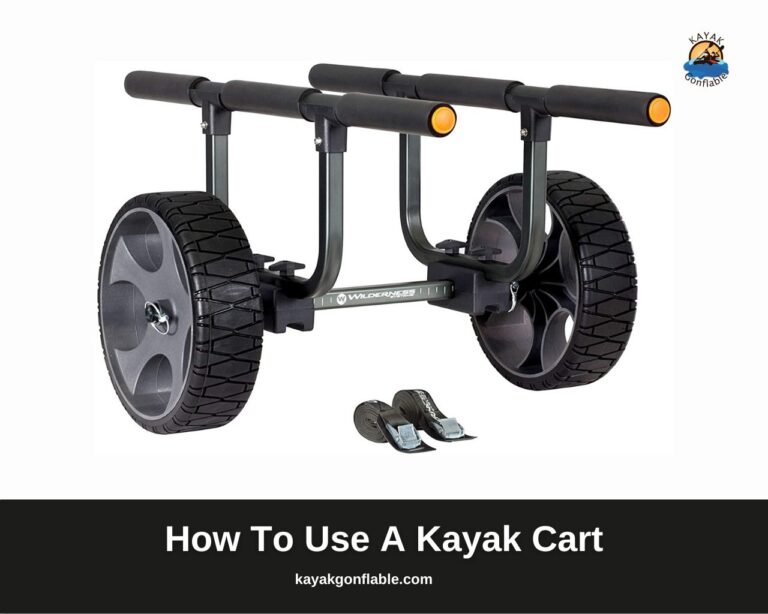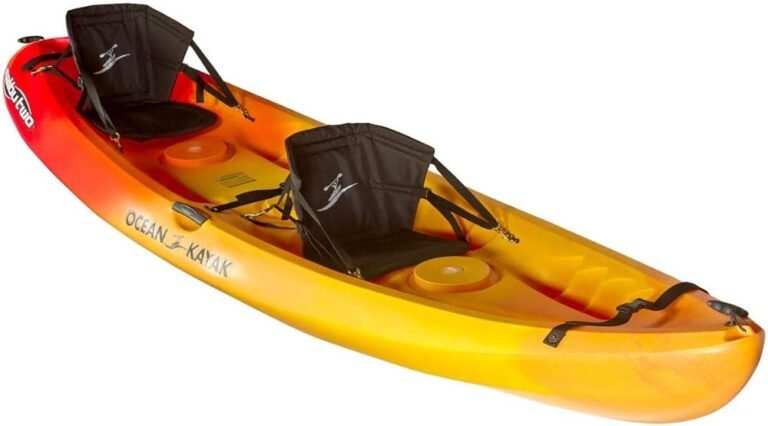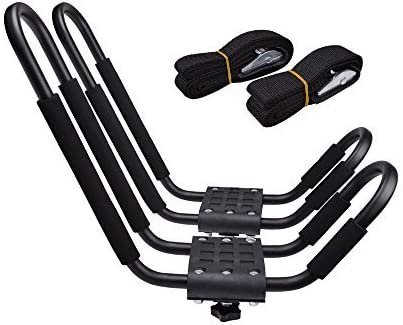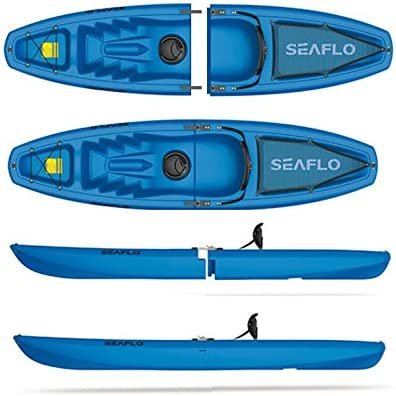10 Best Inflatable Kayaks To Buy In 2025

Should You Buy An Inflatable Kayak?
Those starting out in kayaking are often surprised to learn that there are inflatable kayak options. They quite enjoy the thought of having their kayak packed like a suitcase and moving around anywhere with it.
The feeling of trying it out may, however, fade out from the fear of rips and punctures. The truth is that inflatable kayaks are extremely durable and portable.
They perform just as well as the traditional hardshell kayaks on the market. There are several inflatable kayaks available on the market with varying degrees of quality.
Learn more about the best touring kayaks on the market. Before we dive into the 10 best inflatable kayaks, here’s a little divergence to some other recommendations for inflatable kayaks.
Best Kids Inflatable Kayaks
When young, you most likely want your kids to be with you when kayaking. However, as they grow older, there might be a need for them to have their own kayak.
There are several kayaks available for kids at different kayaking skill levels. Below is a list of kayaks best suitable for kids.
- Advanced Elements Firefly
- Sea Eagle 330
- NRS Rascal
- Advanced Elements Lagoon 1&2
Best Inflatable Kayak for Dogs
If you are adventurous and a dog lover, kayaking with your furry friend might be one thing you would love to try. Kayaking is one of the activities that can be hard to take your dogs along unless you have the right kayak.
One of the common myths is that inflatable kayaks are not a good option for kayaking with your dogs because your paw’s nail might pop the kayak.
It is not a discussion about the kayak being inflatable but more about whether it can provide resistance against punctures and even degradation.
To help you ease your search and narrow down your options, we have collected the best 4 inflatable kayaks for your dogs. The best inflatable kayaks for your dogs are:
- Intex Excursion Pro K2
- Intex Challenger K2
- Advanced Elements Island Voyage 2
- Sea Eagle SE370 Inflatable Sport Kayak Pro
Guide To Selecting A Kayak For Your Dog
The buying guide will cover everything you need to know to pick the right inflatable kayak for you and your paw.
- Single or Tandem Kayak: The best inflatable kayak for you and your dog should offer enough space for both of you as well as your gear. A Tandem inflatable kayak will provide enough space for you, your dog, and your gear. But if you have a smaller pup, a single kayak may be appropriate for your needs. When considering the option to go for, you might want to consider the length and width of the kayak.
- Maximum PSI Rating: An inflatable kayak PSI rating determines how rigid the kayak would be when fully inflated. Many of the best inflatable kayaks in the market are rated for a maximum pressure of 12 to 15 PSI. Generally, a kayak that can handle more Psi will be more stable and easier to maneuver on the water. An inflatable kayak with a maximum PSI of 8 to 10 would provide enough stability and rigidity for you and your dog.
- Materials and Construction: The materials used in the construction of the kayak should be considered. It helps you to determine the durability and ability of the kayak to withstand tough conditions. You should look for a material that can withstand your paw’s nails when standing on the kayak. Inflatable kayaks made from PVC are often more durable for dogs.
- Your Dog Size: The amount of space available on the cockpit of your inflatable kayak depends on your dog’s size. Depending on your dog’s size, you might want to opt for a longer inflatable kayak or a wider one.
- Price: The price of inflatable kayaks that offer durability, and prevent wear and tears are often on the high price. You have to consider your budget when picking your choice of the best inflatable kayak for you and your dog.
Inflatable Kayak Reviews: Our Top 10 Picks
1. The Intex Challenger K2 Kayak
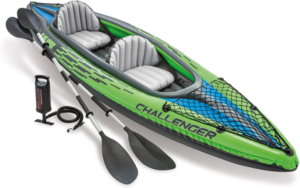
- Length: 11’7”
- Width: 2’6”
- Height: 1’3”
- Weight: 27.5 pounds
- Weight Capacity: 400 pounds
The Intex Challenger K2 is a two-person inflatable tandem made of 30-gauge PVC vinyl. The Challenger is an 11-foot 4 inches inflatable kayak. It provides enough space for two adults and some luggage. The Challenger is the largest inflatable kayak manufactured by Intex.
It is sporty and fun with a streamlined design for easy paddling. The Challenger K2 has a reasonable speed with relatively low air pressure. The skeg provides directional stability. Paddling too fast with a speed of more than 3.8 mph might result in a wobbly experience.
When compared to other kayaks, the challenger K2 reacts quite slowly to changes in direction. The Intex Challenger is a huge benefit on the water. It is very easy to access the water. The seats provide comfortable relaxation but do not do well for longer trips.
Pros:
- It is very affordable with complete accessories included
- It has a great and professional design
- Enough space for paddlers and luggage
Cons:
- The operating pressure is quite low
- The material used for the boat skin is very sensitive
- There are no carry handles on the bow and stern
2. Intex Explorer K2 Kayak
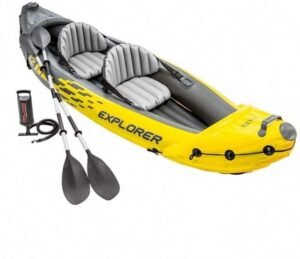
- Length: 123 inches
- Width: 36 inches
- Height: 20 inches
- Weight: 25 pounds
- Maximum Weight Capacity: 400 pounds
The Intex Explorer K2 inflatable kayak is a tandem kayak made from rugged vinyl. The kayak is durable and sturdy. It is an affordable kayak and it is efficient as a high-end kayak.
It features a removable skeg that provides standard directional stability. The Intex Kayak 2 has 2 built-in seats that easily align with your body shape and offer ultimate comfort.
Pros:
- Adjustable seats that allow you to paddle in complete comfort
- The bright yellow color helps in an emergency
- The I-beam floor provides additional rigidity
Cons:
- It is not suitable for large bodies
3. Intex Challenger K1
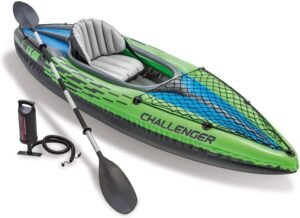
- Length: 108 inches
- Width: 30 inches
- Height: 15 inches
- Weight: 25 pounds
- Maximum Weight Capacity: 220 pounds
The Intex Challenger K1 is an inexpensive inflatable kayak made with welded vinyl construction. The kayak comes with a complete accessories set. The boat offers acceptable directional stability and maneuverability.
The Challenger K1 has little material thickness and too little pressure. It does not do well on long tours on big lakes or fast-flowing rivers. The challenger K1 provides enough legroom but might however be a little uncomfortable for individuals taller than 5.9 ft. It has a comfortable seat with decent back support.
Pros:
- It is very affordable with all accessories included
- It has an attractive design
- It is lightweight and can be carried easily to less accessible waters
Cons:
- It has a small interior
- Low operating pressure
- More of a fun boat designed for short-term flat water.
- Slow on water
4. Sevylor Quikpak K1
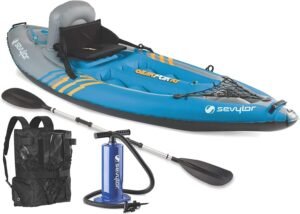
- Length: 103 inches
- Width: 36 inches
- Weight: 18 pounds
- Maximum Weight Capacity: 400 pounds
The Sevylor Quikpak K1 is a solo kayak with an innovative backpack system that carries everything you need and ultimately folds into your kayak seat.
It is a 21-gauge PVC construction with a rugged tarpaulin bottom that handles the rigor of the lake. The kayak features multiple air chambers that allow it to stay inflated if one is punctured.
Pros:
- The backrest and multi-position offers comfort
- Enough storage space
- The backpack can be used as a seat
Cons:
- The tracking is not great
5. Intex Excursion Pro Kayak

- Length: 150 inches
- Width: 25 inches
- Height: 18 inches
- Weight: 39 pounds
- Maximum Weight Capacity: 400 pounds
The Intex Excursion Pro Inflatable Kayak is a tandem kayak ideal for two-person fishing trips. The kayak has a super tough laminate PVC with a polyester core. It is a lightweight kayak with high-pressure inflation that provides extra rigidity and stability.
The kayak has skegs constructed to coast through deep and shallow water and also features a fish rod holder and fish finder. The kayak is made with PVC construction that makes it puncture-resistant and withstands abrasion.
Pros:
- It is an affordable kayak
- It is standard directional and shallow water directional
- It features a removable and adjustable mounting bracket for additional accessories
6. Sevylor Tahiti Plus Kayak

- Length: 142 inches
- Width: 28 inches
- Weight: 34.76 pounds
- Maximum Weight Capacity:440 pounds
The Sevylor Tahiti is a sturdy inflatable kayak that is designed to accommodate two adults and one child. The kayak features a durable PVC hull, two PVC side chambers, floor chamber with I-beam construction for high stability and safety on the water.
It is ideal for lakes, fishing, and seashores. The kayak offers incredible stability and comfort during your trip. The kayak seats are removable and adjustable to provide you with the ultimate comfort while paddling.
Pros:
- It is durable and puncture-resistant
- It features an enhanced backpack system for increased portability
Cons:
- Does not come with a skeg
7. Sea Eagle 370 Inflatable Sport Kayak

- Length: 150 inches
- Width: 24 inches
- Weight: 32 pounds
- Maximum Weight Capacity: 650 pounds
The Sea Eagle 370 is a bigger version of the Sea Eagle 330. It is rated as America’s second most popular inflatable kayak. It has enough storage for long weekend fishing trips, camping adventures, and river-running voyages. It is rated to hold 3 people or 650 pounds.
Pros:
- It is an affordable inflatable kayak
- It is lightweight and portable
- It is remarkably durable and stable
- It is stable for beginners
Cons:
- The free paddle length may not be long enough for shorter paddlers
8. Bluefin Cruise SUP (Inflatable Kayak Conversion Kit)
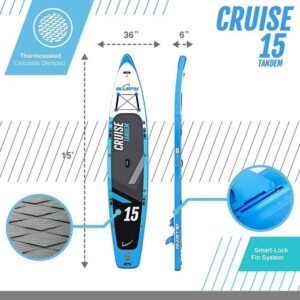
- Length: 180 inches
- Width: 36 inches
- Weight: 38 pounds
- Maximum Weight Capacity:529 pounds
The Bluefin Cruise SUP is a convertible Stand UP Paddle-board and kayak. It has a maximum weight capacity of 529 pounds. The Bluefin Cruise SUP is the most versatile iSUP with rigid stability and great speed.
The kayak features an Exo Surface Laminate Technology for ultra-tough UV-proofed decks. It comes with a conversion kit that makes it easy for you to change into a SUP board or kayak.
Pros:
- It has enough storage space to hold your luggage
- It is durable and affordable
9. Sea Eagle 330

- Length: 134 inches
- Width: 34 inches
- Weight: 26 pounds
- Maximum Weight Capacity: 500 pounds
The Sea Eagle 330 is a solo inflatable kayak with a maximum weight capacity of 500 pounds. SE330 is constructed with 33 mil Polykrylar material and the floor has inflatable I-beam construction.
It is a great kayak for exploring and day fishing. It is incredibly sturdy and stable. It has two rear skegs that improve its tracking and speed.
Pros:
- It is lightweight and portable
- It is made of I-beam tubes that improve the tracking and speed
10. Sevylor Adventure Kit Inflatable Kayak
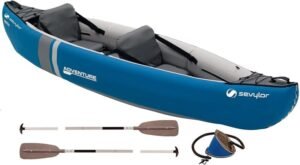
- Length: 124 inches
- Width: 35 inches
- Weight: 25 pounds
- Maximum Weight Capacity: 364 pounds
The Sevylor Adventure inflatable kayak is a sturdy tandem kayak ideal for lakes, fishing, and seashores. The kayak features two removable and adjustable inflatable seats that provide you with comfort throughout your paddling.
The Adventure comes with a durable polyester hull, two PVC side chambers, and floor construction for high stability and safety on the water. The kayak can comfortably seat two persons with a maximum weight capacity of 364 pounds.
Pros:
- It comes with multiple chambers for stability and safety
- The seats offer incredible comfort while paddling
- It is portable
Other Important Mentions
1. Sevylor Coleman Colorado Inflatable Fishing Kayak

- Length: 120 inches
- Width: 39 inches
- Weight: 41 pounds
- Maximum Weight Capacity: 470 pounds
The Sevylor Coleman Colorado is a tandem inflatable kayak made from super-durable PVC, nylon, and tarpaulin. The kayak is extremely durable and puncture-resistant. It is made of multiple air chambers.
It features a fishing rod holder and plenty of meshed pockets to keep bits and pieces secure. The Coleman Colorado is a great boat ideal for fishing. It is incredibly stable and suitable for beginners.
Pros:
- It is easier to maneuver in small bodies of water
- It is trolling motor compatible
Cons:
- It needs some improvement in the tracking
2. Bestway Hydro-Force Rapid X2 Kayak

- Length: 126 inches
- Width: 30 inches
- Weight: 18 pounds
- Maximum Weight Capacity: 350 pounds
The Bestway Hydro-Force Rapid X2 is a tandem inflatable kayak made from sturdy pre-tested vinyl that offers increased safety and reassurance on water. It also features a pair of double-sided aluminum oars for enhanced durability and control.
There is a removable fin that enhances its directional stability and increases speed through the water. The kayak can comfortably seat two people with a maximum weight capacity of 350 pounds.
Pros:
- It is extremely durable
- It is affordable and portable
- It has removable fins for greater speed and directional stability
Cons:
- No pump
3. Driftsun Voyager Kayak

- Length: 120 inches
- Width: 35 inches
- Weight: 37 pounds
- Maximum Weight Capacity: 450 pounds
The Driftsun Voyager is a tandem inflatable kayak that is ideal for exploring lakes and rivers. The boat is made from PVC tarpaulin and tears-resistant coated nylon.
It comes with adjustable and removable padded seats that provide comfort. The kayak also features enough storage space for your gear. It comes with a removable skeg for improved tracking.
Pros:
- Can be padded as a solo or tandem
- Can handle flat water and moderate rapids
- Enough storage area for your gear
- Adjustable padded seats that offer comfort for longer trips
Cons:
- It is not as durable as similar kayaks of the same price
4. Itiwit Inflatable Recreational Sit-On Kayak

- Length: 150 inches
- Width: 42.5 inches
- Weight: 37 pounds
- Maximum Weight Capacity: 507 pounds
The Itiwit Inflatable touring kayak is a kayak with three raised adult seats that offers great comfort all through the paddling period.
The kayak is stable and perfect for family adventures. It has a maximum weight capacity of 507 pounds and can comfortably accommodate 2 to 3 people.
Pros:
- The high seats provide increased comfort
- It is lightweight and portable
Cons:
- The pump is not included
- The paddle is not included
5. Sevylor Tahaa inflatable kayak

- Weight: 18 pounds
- Maximum Weight Capacity: 400 pounds
This kayak is very good for beginners because it’s lightweight and pretty stable. The Sevylor Tahaa Kayak is designed with a decent deal of legroom, this comes in handy for taller folks. Its seats are adjustable and removable and it can be easily paddled by 1/2 people comfortably.
Pros:
- It is ultra-durable and stable
- It is lightweight
- Features easy tracking and directional stability
- Good pressure control and integrated pressure display
- Adjustable removable seats
- Good leg spacing
Cons:
- Low-speed levels
- Low carrying capacity
6. Advanced Elements Lagoon 1 Kayak
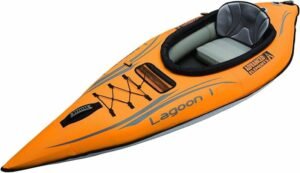
- Length: 100 inches
- Width: 34 inches
- Weight: 23 pounds
- Maximum Weight Capacity: 250 pounds
The Advanced Elements Lagoon 1 is a solo paddler inflatable kayak that is perfect for lakes, mild rivers, and bays. The kayak features built-in rigid panels on the bow and stern which improves its tracking.
The seat is padded and has high back support for your comfort all through your trip. The kayak also features molded rubber-grip handles and bungee deck lacing.
Pros:
- There is an inflatable seat rest which offers you comfort
- It has an inner tube cover for increased rigidity and durability
- It has a tracking fin that helps maintain directional stability
7. Sevylor Big Basin
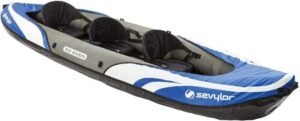
- Length: 147 inches
- Width: 18 inches
- Weight: 34.8 pounds
- Maximum Weight Capacity: 490 pounds
The Sevylor Big Basin is a 3-person inflatable kayak. It is built from rugged PVC with a tough tarpaulin bottom. The kayak is puncture-resistant due to the strong and sturdy material used in the construction.
It features 3 adjustable seats that offer you ultimate comfort all through your trip. The Sevylor Big Basin features spray covers that block splashes and keep you dry.
Pros:
- It can easily fit 3 people
- The gear is constructed to be resilient
Cons:
- No pump is included
8. Bestway Hydro-Force Koracle
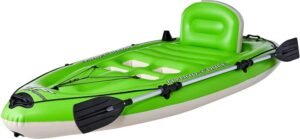
- Length: 106.3 inches
- Width: 39.37 inches
- Weight: 20 pounds
- Maximum Weight Capacity: 330 pounds
The Bestway Hydro-Force Koracle is a solo kayak with a maximum weight capacity of 330 pounds. The kayak features built-in fishing rod holders and oars clasp where you can keep your lines and focus on fishing instead of finding a special place for your paddle.
The cockpit features an adjustable seat with a backrest that offers extra comfort and support for your back throughout your trip. The kayak also features 4 footrests to accommodate riders with different heights.
Pros:
- It is a lightweight and portable kayak
- It has a complete accessory set
- It is affordable
9. Bestway Hydro-Force Cove Champion
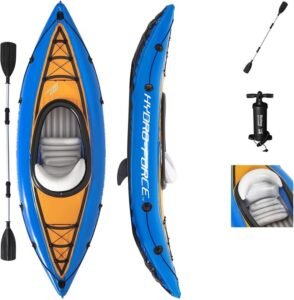
- Length: 108 inches
- Width: 32 inches
- Weight: 36.3 pounds
- Maximum Weight Capacity: 220 pounds
The Hydro-Force Cove is perfect for adventures and exploiting the open waters. It is a solo kayak with a maximum weight capacity of 220 pounds.
The adjustable seat with a backrest provides extra back support for your comfort. The kayak comes with a complete accessories set with a heavy-duty repair patch included.
Pros:
- It comes with all accessories set
- It is lightweight and portable
10. Airhead AHTK-2 Montana

- Length: 144 inches
- Width: 30 inches
- Weight: 36.3 pounds
- Maximum Weight Capacity: 500 pounds
The Airhead AHTK-2 Montana is an inflatable kayak designed for lakes and moderate water. It is lightweight and portable. The kayak has a maximum weight capacity of 500 pounds and weighs 36.3 pounds. It has a construction of semi-rigid heavy gauge PVC construction.
Pros:
- It is easy to maneuver
- It has a highly visible color.
- It is incredibly stable and ideal for beginners and moderate whitewater.
Cons:
- No pump included
11. Aqua Marina Tomahawk Air-K 375

- Length: 148 inches
- Width: 28 inches
- Height: 15 inches
- Weight: 25 pounds
- Maximum Weight Capacity: 262 pounds
The Tomahawk Air-K 375 is a high-pressure drop-stitch technology double-wall fabric that offers incredible rigidity and durability. The kayak is lightweight compared to hardshell kayaks of the same class.
It has multiple D-rings on the side tubes that allow seat position adjusting and provide you with comfort. Tomahawk Air-K 375 has a premium high-back seat with a spongy cushion.
Folding Vs. Inflatable Kayak
When it comes to folding and inflatable kayaks, many people have their preferences. The two types have similarities and differences. We would compare the folding and inflatable kayaks and see how they differ from each other.
What are folding and inflatable kayaks?
Just as the name says, folding kayaks are kayaks that can be folded into smaller parts for easier transportation and storage. They are often made from polypropylene and can seat one or two people.
Inflatable kayaks are the most common portable kayaks. They are constructed from tough and durable materials such as Hypalon, PVC, or Nitrilon. Inflatable kayaks can seat up to three people depending on the capacity.
Differences between Foldable and Inflatable Kayaks
When it comes to transport, performance, and drying, differences exist between foldable and inflatable kayaks.
- Durability: The question of durability is a tough one to answer when it comes to foldable and inflatable kayaks. Foldable kayaks can last for 20,000 folds which is a lot of use. The external material is sturdy, puncture-resistant, and can withstand bumps into rocks and other rough surfaces. Inflatable kayaks are at a higher risk of puncture. However, they are made with durable materials that also withstand rough surfaces. Inflatable kayaks are easily repaired if punctured. Due to the inflation, inflatable kayaks make for a bit more shock absorption when it collides with something.
- Versatility: When it comes to versatility, inflatable kayaks offer more versatility to paddlers. Inflatable kayaks tend to have a higher maximum weight capacity compared to foldable kayaks. Inflatable kayaks are more suited for carrying lots of gear or heavy humans. Inflatable kayaks are also best suited for rough waters, unlike folded kayaks which are more built for calmer waters.
- Drying: Folding kayaks dry out quickly when placed in the sun for a couple of hours because of the non-fabric external shell. They are also easy to towel down so that they dry without spending much time out there. Drying inflatable kayaks takes a longer period compared to foldable kayaks. Due to the fabric shell of inflatable kayaks, they hold water for hours.
- Set-Up: Foldable kayaks are easier to set up. Once you have the kayak out of your bag, all you have to worry about is unfolding the body of the kayak and clipping the parts to get the right structure. An inflatable kayak requires pumping the kayaks as well as a few additional works for separate compartments. Except you have an electric pump for your inflatables, a foldable kayak wins with a shorter set-up time.
Pros of Inflatable Kayaks:
- They are more durable than folding kayaks and don’t get damaged easily
- They don’t require assembling.
Cons of Inflatable Kayaks
- They are heavier than foldable kayaks
- They are more prone to punctures than inflatable kayaks
Pros of Foldable Kayaks:
- They are easy to carry
- They are very cheap compared to inflatable kayaks
Cons of Foldable Kayaks
- They are not durable and get damaged quickly.
Verdict
When it comes to portable kayaks, both inflatable and foldable have their pros and cons. While inflatable kayaks outperform foldable kayaks in terms of versatility, they compromise on their performance. Picking either an inflatable or foldable kayak should be based on your preference and usage.
Inflatable Kayak Pros and Cons
People either love inflatable kayaks or hate them. Owning an inflatable kayak solely depends on choice. Nevertheless, there are pros and cons to owning an inflatable kayak as well as a hardshell kayak.
Some folks might ignore the convenience inflatable kayak gives for other benefits offered by the hardshell kayaks.
Pros of Inflatable Kayak:
- Affordable: On average, an inflatable kayak cost less than a hardshell kayak. For those looking to kayak for recreational purposes, inflatable kayaks are ideal options.
- Easy to transport: Inflatable kayaks are easy to transport and can fit in your car trunk or on your back seat. They are great options to take along on a vacation. With inflatable kayaks, you don’t have to bother about getting help to move your kayak on your car roof or trunk.
- Easy to store: Unlike hardshell kayaks, inflatable kayaks can be deflated, folded, and stored easily. They require little space for storage. For anyone who lives in a condo or a small space, storing your kayak is not a problem.
- Lightweight: one great thing about inflatable kayaks is their lightweight. They can easily be carried by one person. It is easier to get into the water than hardshell kayaks.
- Rugged Construction: Inflatable kayaks are constructed from high-quality materials. They can last very long and can hold against a lot of abuse.
- Performance: Most inflatable kayaks would give a good performance. The performance of inflatable kayaks varies and it depends on the quality of the kayak. The performance of inflatable kayaks is improving every year.
Cons of Inflatable Kayaks
- Speed: One of the common downsides of inflatable kayaks is speed. Most inflatable kayaks can’t reach the speed of a hardshell kayak. However, the speed of inflatable boats is improving. Nevertheless, you don’t have to be the fastest boat on the water.
- Width: Another valid complaint of an inflatable kayak is the width. They often tend to be wider than regular kayaks. The extra width allows for more stability although it takes away from the speed.
- Popping: The possibility of inflatable kayaks popping when you hit a sharp object is very low. Nevertheless, when it occurs, there is a repair kit available to fix it and continue using your kayak. Compared to hardshell boats, the maintenance of an inflatable kayak is low.
Inflatable vs. Hardshell Kayaks
When it is time to buy your kayaks, deciding on what to pick might be confusing. Inflatable or hardshell kayaks might look attractive to purchase. Here are a few things you need to know about inflatable and hardshell kayaks.
What are kayaks made from?
Inflatable kayaks are made from synthetic rubber and plastic polymers. They are designed to withstand several conditions and are portable. Inflatable kayaks are lightweights and weigh around 20 pounds to 50 pounds.
Hardshell kayaks, which are also known as rigid kayaks, are constructed from plastic, wood, fiberglass, and composite materials. Hardshell kayaks are heavyweights and generally weigh around 55 pounds.
Which cost more; inflatable or hardshell kayaks?
Inflatable kayaks are lower in price compared to hardshell kayaks. Inflatable kayaks have grown in popularity due to their sturdy nature. They are constructed to lower the risk of getting tears and leaks.
Heavy-duty inflatable kayaks are higher in price than other inflatable kayaks due to the tougher and more durable materials used in the construction. They are more puncture-resistant and difficult to rip. Hardshell kayaks, however, cost more money than inflatable kayaks.
The cost of wood and fiberglass is much higher than that of synthetic rubber and other materials used for inflatable kayaks. Hardshell kayaks also cost more in terms of repairs and maintenance. They need to be fixed more often than inflatable kayaks.
Transportation and storage
Compared to hardshell kayaks, inflatable kayaks are easy to move around with. You don’t need a roof rack or an additional person to move your inflatable kayak from place to place.
A major advantage of inflatable kayaks over hardshell kayaks is that it is very portable. You can easily fit your inflatable kayak into your backpack. Another advantage of inflatable kayaks is that they require very little space for storage.
You can easily store it inside a closet or put it in a backseat. Once your inflatable kayak is dried, you can store it without having to worry about it taking up space.
Safety
When it comes to kayaking, safety is a major priority. Whether you are kayaking alone or with a partner in a tandem boat, being safe on the waters is important. Hardshells kayaks perform better in rough waters and are the most preferred choice.
Nevertheless, certain inflatable kayaks are designed to handle Class 3 and Class 4 waters with strong currents. All inflatable kayaks are not built to withstand the same conditions.
This is not to say inflatable kayaks are not safe. As long as your inflatable kayak is within the conditions designed, your safety is guaranteed. It is important to check your kayak user manuals to know which conditions it is designed for.
Which Kayak can handle more weight?
Inflatable kayaks have a higher weight threshold compared to hardshell kayaks. This means that inflatable kayaks can carry more weight than hardshell kayaks which have a lower threshold.
Even though inflatable kayaks have a lower weight, they accommodate more weight. This makes them suitable for carrying more luggage such as fishing gear, hiking gear, and other accessories.
Frequently Asked Questions
Are Inflatable Kayaks Safe?
Despite what a lot of people think, inflatable kayaks are durable and are built to withstand tough conditions. Although they are not suitable for all conditions, they are great tools for kayaking beginners.
Inflatable kayaks are made with multiple layers of thick coated materials which increase their structure and stability. Some of the materials used include vinyl and polyester, which are tough and durable.
Except you want to go out there to drag your kayak through the gravel, inflatable kayaks do well under normal wear and tear.
Inflatable kayaks are as safe as other kayaks with tough materials and rigid structures used in the design. You should, however, ensure caution when paddling. Ensure to also use your kayak life jacket when you go kayaking.
Are Inflatable Kayaks Good?
Although there are many pros and cons attached to inflatable kayaks, they are made up of durable materials. Inflatable kayaks are more robust, hardwearing, lightweight, and portable than hardshell kayaks.
This makes them easier to manage than hardshell kayaks. So, are inflatable kayaks any good? The answer is yes.
Are Inflatable Kayaks Worth It?
Depending on your intent of purchase, inflatable kayaks are worth buying. If you consider the lightweight, ease of transportation, versatility, compact size, and smaller space needed to store inflatable kayaks to hardshell kayaks, then yes, they are worth the purchase.
Where To Buy Inflatable Kayak
With different kayak brands available, you can buy inflatable kayaks either at online stores or physical stores.
Before you make the decision to buy an inflatable kayak, you need to research several options available to you. You can then narrow down your search to the kayak that perfectly suits your needs and meets your budget.
To buy your kayak from online stores, you can get them from Amazon, Walmart, and other online stores available in your location. You can also visit the websites of kayak brands to make your purchase if they offer delivery services in your location.
Visiting local stores that are paddle sports retailers is another great option to make your purchase. Experienced retail staff at the retail stores can help you to make the best purchase options.
Do I Need A License For An Inflatable Kayak
Whether to get a license or not to use an inflatable kayak is dependent on your location and where you want to use it.
In the UK, if you intend to use your kayak only on the sea, there is no legal requirement to purchase a license. However, you need to purchase a “Canals and rivers’ license” if you plan to use your kayak on a canal or in a river.
To save costs, you don’t have to purchase individual licenses from each authority. Taking out the British Canoeing “On the Water” membership will grant you access to over 4,500 km of managed waterways in England and Wales.
If you stay outside the UK, it is important that you make findings with appropriate legal bodies in your location so as to have accurate information.
How To Launch An Inflatable Kayak
Before you set out to launch your kayak and begin your on-the-water adventure, you need to master a few skills.
The first thing to take note of before launching your kayak is your launch point. Kayaking in freshwater is different from kayaking in the ocean. Also, launching from the dock is quite different from launching from the shore or ramp.
Launching in an ocean
When launching your kayak from an ocean shore, the first thing to do is to find a place that gradually slopes into the water. This allows you to ease both the kayak and you into the water. You can make use of a kayak damp or the shoreline to get the traction needed to balance as you get in.
Walk the slope into the water while keeping track of the waves. Once you are about knee-deep into the waters, point the nose of your kayak directly towards the surf. Wait till you see a break in the waves, then jump into your kayak as quickly as possible before the next wave hits.
Launching in rivers and lakes
Launching your kayak in rivers and lakes is quite easier than in oceans. There are no strong tides or crashing waves like you would experience in an ocean.
If you have someone who can help hold the kayak stable, launching your kayak would be quite easier. Don’t worry if you don’t have anyone to hold the kayak stable for you. You can easily launch your kayak through the following steps.
- Carefully move your kayak towards the water edge with the nose extending far enough into the water. Make sure the cockpit area is floating with the end of the kayak still on the sloping shore.
- Stand on one side of your kayak while holding your paddle with both hands, evenly spaced behind you.
- Lean down while still holding the paddle and rest the handle of your paddle against the back seat combing. While still holding the paddle, hold on to the back of the seat to balance yourself. Press the flat side of one paddle blade against the ground. This allows you to use the paddle to help center your weight and balance while getting inside your kayak.
- Centre your weight over your paddle and use it to stay balanced as you start to enter the cockpit. Use the stability from the paddle and your grip on the kayak seat to maintain your balance. Bend your knees as if you are going to sit on the paddle while still standing in the water.
- You should be stable enough while standing in this position to enter the kayak feet first. Remember to keep your weight centered on the paddle and ground. Once both feet are in the cockpit, press both feet against the foot pegs and shift your body so you can climb the rest of the way in.
- When you are seated, lean back against the backrest and adjust until you are comfortable before attaching your spray skirt.
Propel the kayak forward with the paddle in one hand and a fist in the other hand. With one hand on each side of the kayak, propel the kayak forward while using your hips to help push your kayak. Once you are away from the shore and in the water, you can paddle as usual.

Image Source: https://www.ez-dock.com/blog/how-to-launch-a-kayak/
What Is The Best Inflatable Kayak To Buy?
The best inflatable kayak for you to buy depends on several things. You have to consider your budget and other preferences before making the decision on what to buy.
If you are to choose the best kayak that suits you, you might have to consider the strengths and weaknesses of the options available to you. You have to consider the material used in the production, the maximum capacity, transportability, and storage.
How To Paddle Inflatable Kayak
As a kayaker, having good control of your kayak would determine your kayaking experience. Using the right paddling techniques would help you to maintain a smooth and enjoyable ride.
As a beginner kayaker, you need to learn three main paddling techniques before you begin your ride. Having a good knowledge of forward paddling, reverse paddling, and turning the kayak will help you to become a seasoned kayaker with time.
All these three techniques are easy to learn. Learn more about our top pick for the 12 best kayak GPSs on the market.
Forward Paddle: This will be the commonly used paddle stroke. To forward paddle, make sure that you are sitting up straight in the kayak and your feet are right up against the footrest. This will help you get a more powerful stroke.
Relax the grip on the paddle and place the paddle in the water close to the kayak around where your feet are. Make a deep stroke and pull backward. You should be gliding through the water. A good pair of kayak gloves would help prevent tears and wear on your hands.
Reverse Paddle: The reverse paddle won’t be used often but it is important that you master it. You will use the back of the paddle blade for the reverse paddle and place the paddle in the water near your hips.
Push the paddle near the trunk of your kayak while turning your torso. Keep your elbows bent to avoid injuries and pull the blades out of the water when it is even with your knees.
Turning the kayak: Being able to turn your kayak is quite important to avoid unnecessary crashes. It is important that you learn to properly turn your kayak. An effective way to turn your kayak is to do a deep reverse stroke on the side of the direction you want to turn.
How To Inflate Intex Kayak
Before you go ahead to inflate your inflatable kayak, you need to be mindful of where you set up to inflate. The selected location must have a clear and open space. This would ensure safety and prevent any form of accident.
Make sure the space is free from sharp objects which can harm your kayak. Ensure the selected location is close to the shore so you won’t have to do extra work carrying an inflated kayak further on the land.
Laying the inflatable kayak out for inflation
- Spread out your inflatable kayak on the floor from end to end.
- Ensure there are no folds in the compartments.
- Before you start to inflate, identify where each of the valves to be pumped is located.
Inflating the kayak
- To inflate your kayak, start with the floor compartment then move to the sides.
- Top off the sides until both are mostly inflated for best practice.
- Don’t forget any other compartments when inflating.
- When using a self-powered pump, be efficient in your movements and effort. Make sure you don’t fatigue yourself in the process of inflating before even paddling.
- Be in a comfortable body position when inflating to avoid initiating a sore back.
- When pumping, rapid movement doesn’t necessarily equal quicker inflation. You can switch feet and hands respectively for foot and hand pumps to keep things even and limit soreness.
- When inflating, familiarize yourself with the appropriate level of PSI for each compartment. Make use of any tools provided for measuring PSI.
After inflating, make sure you check that every compartment is evenly inflated for better stability and balance when paddling on the water.
How To Deflate Intex Inflatable Kayak
To deflate your inflatable kayak, you need to get yourself and your kayak out of the water. Step out onto a dock and set the kayak on an open, flat, and non-poky surface.
Once you are done with this, clear out and set the seats, paddle, and other things aside. Clean off the kayak by rinsing it with water and ensuring any water inside it drains.
Before deflating, make sure your kayak is dry either by air drying or manually drying. Slowly deflate the compartments by unscrewing the valves and eventually taking out the valves completely.
Start with the sides when deflating before moving to the floor. Apply some pressure to the compartments to get as much air as possible out. Partially screw the valves back in before you start to fold and press out the remaining air.
Once all the compartments are deflated, you can start folding your inflatable kayaks such that open valves are exposed. Continue to fold your kayak and press out the remaining air before closing the valves. Fold the inflatable kayak tightly into a shape that best fits your bag.
How Long To Inflate Kayak
Inflating an inflatable kayak is not difficult and won’t take much time. Depending on the size of your kayak, you can expect the pumping to take about 5 to 8 minutes. When using an electric pump, you should expect to get it done in about 2 minutes.
How To Get In And Out Of Inflatable Kayaks Smoothly
In general, getting in and out of an inflatable kayak requires just a few steps which include;
- Stabilizing the kayak
- Positioning your feet and legs inside the cockpit of the kayak.
- Transferring your entire weight to the seats of the kayak.
- Sliding and repositioning your legs on top of or inside the kayak.
One of the best ways to get into your kayak is to straddle the boat while standing in the water. Once this is done, you can then sit down in the kayak and place your legs inside or on the kayak. Doing this does not put excess weight on the kayak and prevents it from tipping.
This method won’t work if you are unable to launch your kayak into shallow waters where you can straddle the boat.
When getting in or out of your kayak, always try to be careful and keep a well-balanced position to avoid any problems. Below is a video explanation to guide you on how to get into and out of your inflatable kayak.
How To Fold Inflatable Kayak
To fold your inflatable kayak, you must make sure all compartments have been deflated. Start folding your inflatable kayak so that the opened valves are exposed instead of being buried.
Continue folding the kayak and pressing out the remaining air before folding the kayak. Once this is done, fold the inflatable kayak into a shape that best fits your bag for storage.
Can One Person Use A 2-Person Inflatable Kayak?
A tandem inflatable kayak can be converted into a solo kayak. A few of the tandem inflatable kayaks have seats that are moveable and can be converted into solo kayaks. You can decide to bring someone with you on your kayak or go solo.
Can You Fish From An Inflatable Kayak?
Inflatable kayaks are excellent boats for fishing. The sheer versatility of inflatable kayaks makes them a great fishing platform.
Inflatable kayaks can easily be transported to a fishing location and are made of plenty of storage rooms for your fishing gear. Whether you fish in rivers, lakes, streams or oceans, there is an inflatable fishing kayak suitable for you.
Do I Need Insurance For an Inflatable Kayak?
An inflatable kayak is categorized under non-motorized boats. You are not required to get insurance for a non-motorized boat. However, you can get insurance coverage for your kayak in case of theft, accidents, or damage.
Do Inflatable Kayaks Pop Easily (Can Inflatable Kayaks Pop)?
Under normal usage, inflatable kayaks manufactured by reputable brands are at little risk of popping. Unless you don’t take appropriate care of your kayak, you should not worry about your kayak popping.
Inflatable kayaks are made from tough materials designed to withstand tough conditions and are far more puncture-resistant.
How Long Do Inflatable Kayaks Last?
How long your inflatable kayak lasts depends on your usage and maintenance. Generally, inflatable kayaks last around 5 to 10 years. The material used in the construction of your kayak also determines how long your kayak will last.
It is advisable that you wash your kayak after each use. Proper cleaning, drying, and storage of your kayak helps to prevent quick degradation of the materials used in constructing your kayak.
How Heavy Is An Inflatable Kayak?
Generally, a typical kayak weighs around 30 – 40 pounds. The average weight for solo paddlers’ kayaks is about 30 pounds and a tandem inflatable kayak has an average weight of about 40 pounds.
An inflatable kayak can weigh anything from 20 pounds to 50 pounds depending on the length, application, structure, gears, and whether the kayak is for solo paddlers or tandem.
Can You Use An Inflatable Kayak In The Ocean?
Inflatable kayaks, contrary to what a lot of people think, are durable. They are built of incredibly durable materials and can withstand tough conditions. Inflatable kayaks can be used on flat water, rivers, and even the ocean.
How To Store An Inflatable Kayak
Unlike rigid kayaks, inflatable kayaks are very easy to store. You don’t need a lot of space to store your inflatable kayaks. Once you have it deflated, you need to keep it in a dry cool place.
When storing your kayak, it is best not to leave it inflated. Leaving it inflated while storing for a long period can cause stress on the seams and valves if the temperature increases and the air expands.
Are Inflatable Kayaks Safe In Florida?
There is no straight answer to whether it is safe to kayak in Florida. Florida is made of brackish and fresh water. Brackish or freshwater is home to alligators which can be a cause of concern for some paddlers.
It is important that you are aware of your surroundings before you go kayaking. Some steps to take when kayaking in these areas include kayaking during the daytime, avoiding swimming in the water, choosing a more studier kayak, and be very alert.
What To Look For In An Inflatable Kayak
There are several brands and types of kayaks with varying prices available on the market for you to choose from. Before you make the decision on which to pick, you need to consider a few things. The main things to watch out for in an inflatable kayak include;
Layer/Structure: When picking out an inflatable kayak, you need to know the material used in the construction as well as the number of layers it has. Single-layer vinyl inflatable kayaks are ideal for light recreational use where you will be paddling for an hour or two.
This type of kayak is best suited for sheltered water environments. Single-layer vinyl inflatable kayaks are very affordable. Multi-layer vinyl inflatable kayaks are far more versatile than single-layer vinyl kayaks. They are designed to offer much more protection against abrasion punctures and UV light.
Multi-layer vinyl inflatable kayaks are designed with inflated vinyl encased in a protective outer fiber that performs these functions. Multi-layer vinyl inflatable kayaks are best suited for paddling for a couple of hours.
Heavy-duty inflatable kayaks are made of thick materials that allow them to withstand quite a lot of rough conditions without the fear of puncturing.
Materials like PVC, rubbers, or drop stitch technology are used in the production rather than vinyl which makes them the most durable inflatable kayak category. They are best suited for heavy recreational usage in moderate water environments.
Performance: Another consideration to make before you purchase an inflatable kayak is the performance. Single-layer vinyl kayaks are best suited for sheltered water environments because they are easily affected by the wind.
If you consider kayaking beyond sheltered waters, you might want to consider buying a multi-layer or heavy-duty inflatable kayak. Another thing to consider is being able to keep your kayak straight when on the water.
You might want to consider going for an inflatable kayak with a skeg. A skeg is a tracking fin that helps to keep the kayak going straight (directional stability). It saves you the energy wasted in trying to keep the inflatable kayak straight.
Seats: The number of seats available on the kayak should also be factored in before you make the purchase. If you would go kayaking with your partner, a tandem inflatable kayak would best suit your needs as compared to solo paddler kayaks. You might also want to get a robust seat if you know you will be kayaking for long hours.
Cleaning: One major factor often overlooked when selecting a kayak is the ease of cleaning. You should know how long it would take to clean, dry, and pack your kayak. Single-layer vinyl and heavy-duty inflatable kayaks are relatively easy and quick to clean compared to multi-layer vinyl kayaks.
Not cleaning your kayaks well and leaving them undried can make them smelly and damage the kayak over time. Cleaning and drying your kayak well will prevent the spread of invasive species across different waters.
Storage: The ease of storage is another major consideration when picking your inflatable kayak. Single-layer and multi-layer vinyl inflatable kayaks are easy to store and won’t take over all the space in your room.
If you know you won’t be using your kayak regularly, then you might want to consider kayaks that are easy to store.
Paddle and Pump: You might want to consider the quality of the paddle and pump packaged with the kayak. It is recommended that you invest in a stronger paddle for your safety as many of the packaged paddles and pumps are of poor quality.




